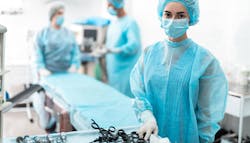Resiliency is a perfect term to describe the efforts of the healthcare industry during the COVID-19 pandemic, where care providers have confronted unparalleled challenges with courage, strength and an unwavering commitment to their patients. With the halt in elective procedures and subsequent ramp up to perform the countless procedures that had been cancelled or delayed, Central Sterile/Sterile Processing Department (CS/SPD) professionals and Operating Room (OR) teams have shown remarkable resiliency in navigating the many challenges they have faced, and continue to face, in delivering effective and safe patient care.
While surgical procedures were on hold, CS/SPD and OR teams in health systems and hospitals took the opportunity to examine their processes and make improvements for when cases resumed, not just related to protecting patients against the spread of COVID-19, but also to address long-standing challenges experienced by both departments.
Here are some of the ways that CS/SPD and OR teams have worked individually and collaboratively to bring back surgeries in a safe and effective way during this unprecedented time in healthcare delivery.
Stepping up in the CS/SPD
Throughout healthcare facilities, COVID-19 has driven personnel to step up to the challenges presented by the pandemic and take on additional roles and tasks that they would never have considered before the virus emerged. It has also forced greater collaboration and communication among departments, including supply chain, infection control/prevention, CS/SPD and the OR. These strengthened interdepartmental partnerships are more important than ever as facilities resume surgical procedures, particularly the relationship between the CS/SPD and OR.
Added support to the OR
“The OR and CS/SPD must take a proactive versus reactive approach, communicating on staffing and case volumes,” said Owens. “This should include needs assessment to determine education, training and competency needs. In addition, there should be cross training between departments - OR learns what SPD does, SPD learns what OR does.”
During these challenging times, with reduced on-site access due to pandemic related restrictions, Owens recommends that CS/SPD professionals use online or virtual resources for continuing education and in-servicing that manufacturers often provide.
At Mount Sinai Hospital, Toronto, Bassi and his CS/SPD team have launched many initiatives to support the OR as they resume procedures. For example, they are providing additional support for weekends where extra surgeries and extra rooms are being opened up to catch up on the backlog of surgeries and wait lists. They also prepare additional case carts specifically to contain COVID-19 case instruments that are clearly labeled as being used on a patient with the virus, so that the CS/SPD team is aware of these instruments when they arrive in decontamination.
In addition, Bassi and his team are working with OR to provide alternatives to disposables (e.g. reusable gowns) so the supply chain impact can be lessened, performing stock rotation of their inventory, and helping to refill alcohol hand rub containers using an aseptic process that was developed in-house.
Supporting CS/SPD staff
Disruptions in patient procedures have had a profound impact on CS/SPD workload, with many facilities having to furlough/lay off employees in their departments or drastically cut their hours. As a consultant, Duro has seen healthcare facilities implementing creative staffing plans to keep CS/SPD professionals employed during the pandemic. This includes reassignment of CS/SPD staff to other areas of the healthcare facility to keep them active, especially in areas where existing staff have contracted COVID-19 and cannot work.
“Many have taken the downtime to improve their service and processes by doing extra preventative maintenance on instrumentation and other reprocessing equipment,” said Duro. “Others have completed deep cleanings of their processing, decontamination and storage areas. The same has applied to ORs. Although this pandemic has wreaked havoc on healthcare facilities, it has also given them a chance to do things that normally can’t be done during the ‘norm.’ As we open up, many facilities are in a much better position than they were before the pandemic.”
Acknowledging how the pandemic has placed added stress on not just the OR but the CS/SPD staff as well, Mount Sinai Hospital, Toronto has taken steps to promote a positive environment within its CS/SPD.
“We offer resilience and change management sessions to keep staff positive, and maintain regular communication to our staff regarding COVID-19 cases, including a COVID-19 update page for all staff and regular town halls; and we provide regular acknowledgement of our staff in various ways to keep the positivity and momentum going,” said Bassi.
Collaborating for clean
“Since ORs were permitted to reopen to elective surgeries during the COVID-19 pandemic, there has been an increased awareness of the importance of the OR-CS/SPD collaboration,” said Dybec. “The procedures that were working in achieving guaranteed clean and sterile instruments before the pandemic were revisited once again.”
According to Dybec, these methods include effective point-of-use cleaning and instrument prep with enzymatic humectant and foam solutions in the OR. He says this process alone has demonstrated increased cleaning effectiveness in the CS/SPD and quicker turn-around of critically needed instruments.
At Mount Sinai Hospital, Toronto, Bassi and his CS/SPD team have minimized hand wash processes as much as possible and are currently washing the majority of their devices through their thermal washer/disinfectors to protect staff who are handing contaminated equipment (e.g. rigid scopes and light cords and anesthetic equipment).
Dybec adds that systems for checking for the cleanliness of instrumentation, such as adenosine triphosphate (ATP) devices, have become profoundly more important during the pandemic. He notes how these devices can also be used to check for cleanliness in many other areas of the hospital and on multiple surfaces.
“The ‘new norm’ has shown how important it is to clean and disinfect critical areas such as the OR, emergency department, COVID-19 units and intensive care units (ICUs),” said Dybec.
Steps to ensure sterilization
The dangers of COVID-19 infection and the delays in surgical procedures related to the pandemic prompted many healthcare facilities to reevaluate their sterilization processes, supplies and systems.
Biological indicators
Early this year, healthcare facilities notified the U.S. Food and Drug Administration (FDA) of the potential for misinterpreting indicators used to validate the sterilization of medical devices because there is no standard indicator color to indicate a sterilized device. In a letter to healthcare providers, the FDA indicated that the risk for misinterpretation has increased with the COVID-19 pandemic as healthcare facilities “are rapidly adopting conservation practices, including decontaminating disposable compatible N95 and N95-equivalent respirators for single-user reuse.”
The letter went on to explain how “reprocessing staff may be using sterilization systems for the first time or concurrently using sterilization systems from different manufacturers,” during the pandemic; therefore, “if staff assume that all manufacturers use the same color code to validate sterilization, they may mistakenly release contaminated devices for reuse.”1
During the time when COVID-19 necessitated a hold on elective surgeries, some healthcare facilities took the opportunity to address the issue of sterilization indicators by upgrading their technology and/or standardizing on one manufacturer’s biological indicator (BI) as a way to minimize the risk for misinterpretation of results.
According to Loguidice, a biological indicator within a process challenge device (PCD) is the best method used to demonstrate whether the conditions during a sterilization cycle were adequate to achieve a defined level of microbial inactivation. She notes how in recent years biological testing technologies have been perfected to provide results in 30 minutes or less.
“This advancement has made it possible for the CS to discern that surgical instruments and supplies have been processed and sterilized properly before being sent to the OR,” said Loguidice.
For those facilities where there is the potential to misinterpret the indicators used to validate the sterilization of medical devices, Loguidice recommends developing an action plan to continually monitor and instruct the staff in the OR and CS/SPD as to how to interpret the indicators. As part of this plan, she suggests the posting of physical charts illustrating what indicators should look like pre- and post-sterilization (including positive and negative results) at the point of use for staff to reference.
She also recommends that healthcare facilities take advantage of resources provided by indicator manufacturers, including educational sessions and training programs they offer to staff members who interpret indicator results.
“Additionally, standardizing and limiting the variety of indicators used can be helpful,” Loguidice added. “Clinical input from CS and OR healthcare professionals may provide healthcare facilities important insight when making these decisions.”
Bassi says Mount Sinai Hospital, Toronto standardized to one indicator type many years ago as a way to avoid confusion and drive accurate interpretations among staff members.
“This helps with consistency and education around recognition amongst the OR and all other areas in the hospital,” said Bassi. “Different departments borrow instrumentation from one another; therefore, having one type of indicator across the board helps with that consistency.”
Owens says sterilization indicator manufacturers have designed products that are easier to use and interpret to support accurate and efficient testing, stating:
“One example is a moving front chemical indicator – it allows for easy confirmation that the testing was successful providing confidence in the release and use of instrumentation.”
Sterilizers
As Duro points out, because of limited number of surgical procedures performed during the pandemic, CS/SPDs may have used one sterilizer to accommodate instruments from emergency cases, while their other sterilizers sat idle for months. Healthcare facilities have been asking him for advice on how to resume use of these sterilizers now that surgical procedures have resumed. He states:
“I had a customer ask what they should do if they had two of their three sterilizers shut down for the past two-to-three months. What should they do to bring them back online after this work has been done? Depending on the work that has been done (especially after major repairs) and if the unit has been down for extended periods of time (months), we recommend requalifying sterilizers according to Association for the Advancement of Medical Instrumentation (AAMI) recommendations, although in some cases it may not be necessary based on each unique situation. We want to do what is in the best interest of the patient and definitely requalify your units. It’s not worth the risk.”
Instrument tracking and scheduling systems
As Owens explains, instrument tracking systems are a valuable tool for healthcare facilities as they manage surgical procedures during COVID-19 – and even in a non-pandemic environment - allowing both the OR and CS/SPD to balance instrument availability with procedure volumes.
“Instrument tracking systems provide insight into inventory, including what is being used and what is available, and what are current volume considerations/constraints,” said Owens.
According to Duro, during the COVID-19 downtime in the CS/SPD and OR, staff members have taken the opportunities to address tracking and scheduling systems, including making updates, changes, deletions and additions to tighten up databases and ensure their accuracy, performing software updates, and exploring new technologies to ensure they are “providing the best in patient safety.”
“Tracking and tracing systems for surgical instrumentation has become a great way to follow the sterilization process from start to finish by barcoding and scanning instrument trays throughout the entire process,” said Dybec.
Loguidice points out how biological indicator results can be downloaded into instrument tracking systems, automating the documentation process, and enhancing data management reporting and information on load retrieval.
“The instrument tracking program has become an essential component for every CS and OR,” she said.
Looking forward
Throughout the healthcare industry, there is widespread uncertainty around how COVID-19 will impact care in the months ahead. While efforts are underway to develop a vaccine, most agree that healthcare organizations will be providing care in a pandemic environment for quite some time. For example, for HCA Healthcare, one of the nation’s leading providers of healthcare services, COVID-19 patients represent about six percent of patient admissions and leadership doesn’t believe this volume will be dropping anytime soon.
“We believe we will continue to treat COVID-19 patients through 2021,” said HCA’s CFO Bill Rutherford. “We believe it is reasonable to estimate about four-to-five percent of 2021 admissions could be related to the virus.”2
As Duro points out, CS/SPD and OR staff must continue to evolve along with a changing healthcare delivery environment: “Administration in many facilities have been planning even though they are unaware of the future, and who knows, we might have to take steps back again, so CS/SPD and OR always have to be ready to adapt.”
References:
- Risk of Misinterpreting Hydrogen Peroxide Indicator Colors for Vapor Sterilization: Letter to Health Care Providers, https://www.fda.gov/medical-devices/letters-health-care-providers/risk-misinterpreting-hydrogen-peroxide-indicator-colors-vapor-sterilization-letter-health-care
- COVID-19 cases could be 5% of 2021 admissions, HCA says amid rising Q3 profits, HealthcareDive, October 26, 2020, https://www.healthcaredive.com/news/covid-19-cases-could-be-5-of-2021-admissions-hca-says-amid-rising-q3-prof/587723/
About the Author
Kara Nadeau
Senior Contributing Editor
Kara Nadeau is Sterile Processing Editor for Healthcare Purchasing News.






